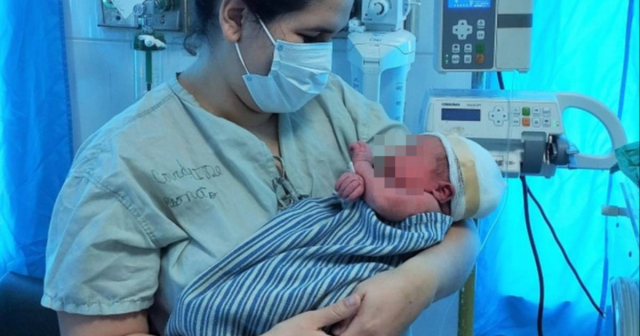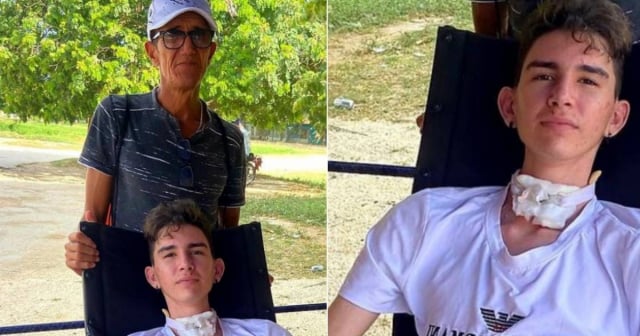
PINAR DEL RÍO, Cuba—From the day of her birth there is an image that she cannot forget: when she saw her baby for the first time and his body was a grayish tone, as if he were lying inert.
Shortly afterward he learned that he had been born cyanotic, almost dead due to lack of oxygen, after a long delivery. The baby's medical record describes doctors resuscitating him, still covered in blood and fluid, looking for a heartbeat, the mother recalls.
During the months of gestation, the mother had had an ideal pregnancy supervised by several doctors. In 39 weeks there had been no abnormalities on ultrasounds, nor gestational diabetes or hypertension.
The fact that the mother underwent a prolonged labor may be the most likely cause of the length of time the fetus was oxygen-deficient at the time of delivery.
Furthermore, the mother, a 22-year-old medical student whose identity we are protecting for fear of reprisals from the Government, entered the maternal block of the Abel Santamaría hospital in Pinar del Río, at the western end of Cuba, waiting to give birth to a healthy baby. .
But everything started to go wrong since she was forced to enter the delivery room alone without being allowed the company of a family member.
It was a small room, without much space to walk, with the patients' beds very close, less than a meter away, from those of five other patients, most of whom were uncomfortable due to the pain and narrowness. It was a little bigger than a regular bedroom, the mother said.
During the following 21 hours she was trying to give birth without the cervix dilating the ten centimeters necessary for a natural birth, confirms the doctor at the office who followed her pregnancy from the beginning and whose identity we reserve because the doctor does not want to risk her job and also fears reprisals from the government.
At that time, the option of a cesarean section was not considered, despite the fact that the patient requested it and that hospital protocols establish an average of one centimeter of dilation, per hour, in the natural birth of first-time mothers. This stage must conclude at the end of twelve hours.
The young medical student, sore and fatigued, had no choice but to wait almost twice as long.
She says that from the gynecologist who assisted her she got the same response to her every gesture of pain. “Hang in there and bid, I'm not going to get it out of you. You have to give birth to it,” he said.
The mother remembers that she struggled and, drenched in sweat, pushed and pushed until she felt her body stopped responding.
After almost a day of trying for a natural birth, doctors found signs of fetal distress. Then they made one, which is a cut in the perineum located between the vagina and the anus, which facilitates childbirth.
But it was too late.
“I was always aware and from the first moment I saw my son I knew he was not well,” said the mother. “Then the neonatologist who treated him told me that there was no chance of him surviving, that he would die any moment from cardiorespiratory arrest.”
Until 2017, Cuba had a high rate of cesarean sections, according to the following year's health statistical yearbook.About 30 percent of births ended this way.
This happened for several reasons. Among them, gynecologists had financial incentives to practice this type of surgery because it was common for them to charge mothers “under the table.”
But many cesarean sections were also the consequence of a health system that has not yet introducedhumanized birth, common in other nations, and that facilitate giving birth naturally.
Among these measures are filial accompaniment, the use of analgesics, space to walk during labor and the mother having an active role in the decisions made about the birth.
For three years, however, it has been more complicated for doctors to have cesarean sections because the Cuban authorities introduced theRobson protocol, a standard global classification system that seeks to reduce the number of cesarean sections.
The objective was to get closer to what the World Health Organization considers ideal: surgical intervention between a10 and 15 percent of births that take place in the country.
A cesarean section is an operation and brings with it the possibility of postpartum hemorrhage, reactions to anesthesia and embolic phenomena, explains Laura Tabares, a gynecologist at the Ramón González Coro hospital in Havana.
On the other hand, childbirth is a physiological process whose recovery is faster and safer. According to the specialist, with a cesarean section there is also a risk of “immediate, mediate or late complications, from bleeding (three times more than in a normal delivery) or reactions to anesthesia.
“In addition, women have a more torpid (difficult) evolution because they have to eat after they go to the bathroom, so they need a liquid or semi-pasty diet,” said Tabares.
Tabares adds that the patients cannot walk well, their abdominal wall is affected and they lose sensitivity in the surgical wound.
But despite the advantages of natural childbirth over surgical interventions, in Cuba the introduction of this policy to reduce them has led to situations like the one experienced by the medical student: women who needed a cesarean section who did not receive it on time and whose children suffered. the lifelong consequences.
In Cuba, between 2017 and 2018, according to official statistics, the number of children who died from causes related to childbirth increased. The mortality rate for children under seven days old was 12.9,the worst since 2009 when the same figure was recorded.
But mortality statistics do not count cases like this young woman's baby who was born cyanotic. Although he survived, the boy suffers from a type of irreversible cerebral palsy.
He cannot walk, move his arms, or look at objects that attract his attention. The possibility of a common life was taken away from him by delaying his birth.
agreed birth
For a long time it was common for mothers and doctors to agree on cesarean sections. For gynecologists it was beneficial: they could receive money or gifts in exchange for committing to perform surgery.
In Havana, the capital, the price is usually higher than in the interior of the island. The rates ranged between 50 and 150 CUC (equivalent to the US dollar), although they varied depending on the region of the country, according to the couples consulted.
It is presumed that the salaries of specialist doctors in Cuba range between 1600 and 1800 Cuban pesos (64-72 dollars) including medical guards.
Furthermore, this pact allowed them to turn the birth into a predictable and controllable event, which could happen at a specific time. For many women this was reassuring, especially those facing the possibility of complications during childbirth.
For this reason, for decades the number of births that ended in cesarean sections multiplied in Cuba. Between 1970 and 2011 the rate went from almost 4 percent to just over 30 percent.
The increase accelerated from 2004 to 2011, with one percent annual growth,according to the health statistics yearbook. In the following years it remained with average figures of 30.5 percent.
Another young Cuban who asked to reserve her identity, also a first-time mother, was promised that her first birth would be a cesarean section. She, a microbiologist who lives in the Consolación del Sur municipality, traveled the 25 kilometers that separate her from Pinar del Río, always with gifts in her bag in advance of the agreed intervention.
“Throughout the entire pregnancy, the gifts were constant for the obstetric-gynecological team that cared for me,” says the 29-year-old mother. “Sometimes recharge cards for cell phones, perfumes, pieces of meat, clothes. “My husband and I did not skimp because it was about my safety and that of our son.”
The couple's concern was not unfounded, although their pregnancy did not present any alterations and their baby was a healthy child, the specialist who attended the ultrasound sessions assured them that the dimensions of the fetus exceeded the possibilities of a natural birth and that it Better was a surgical intervention. But when it came time to give birth, in January 2018, things did not happen as planned.
By then, Cuba had radically changed its protocols on cesarean sections by introducing the Robson system in 2017. Thus, the island went from excessive use of the procedure (30.5% of births) to a historical rate of 18.3%. , by applying other stricter criteria to reduce the number of interventions.
In the hospital where both patients were admitted, the final decision about performing surgery does not belong to the gynecologist who assists them, but to the director of the maternal section.
The cesarean section agreed upon between the young microbiologist and her doctor never occurred despite the size of her baby, which had been assessed beforehand as larger than the mother's cavity.
According to the mother, the doctor who received the gifts never arrived at the hospital as agreed. He also did not answer the phone calls made by the mother's relatives. Apparently, he knew in advance that a cesarean section could not be performed.
The woman endured 22 hours of contractions and pain. During this time, signs of fetal distress were detected, says the doctor at the office who attended her pregnancy, but the specialists refused to intervene and opted to continue with the vaginal delivery.
Without asking for her consent, a cut was made in the patient's perineum. He says that the incision reached the muscle and was then sutured with at least five stitches at a deep and superficial level.
At the time it may seem like a short and simple intervention, but in the days after delivery it is painful.
“The suture is extremely annoying when you sit down to breastfeed,” says the young woman. “It can open if you exert yourself physically or go to the bathroom. You must endure the burning or itching as the hair grows in the intimate area, without being able to touch the points. For doctors it seems to be a routine procedure, but for women, episiotomy does not end the day we give birth.”
After the cut on the perineum, her baby came into the world with severe depression and his mother remembers that she did not hear him cry until a few minutes after delivery.
Throughout his first twelve months, the consequences caused by dilated labor have marked the life of the child and his family. The little one cannot grasp objects, walk, laugh or try to communicate in any way like other babies his age do.
At the Institute of Neurology in Havana he was diagnosed with West Syndrome, an irreversible condition that causes seizures and severe developmental delays.
The family doctor who is following the case assures that “the child will never be able to speak or walk due to the bad practices at birth.”
from one side to another
Reducing the number of cesarean sections was a desirable objective, but several specialists consulted agreed that it has gone from allowing the agreement to perform multiple cesarean sections to very few or none.
“We are practically not allowed to perform surgical interventions on pregnant women,” said a gynecologist who requested anonymity due to the risks involved in revealing this information to the independent press in Cuba. “We are threatened with administrative sanctions that have already been applied to some colleagues if we risk operating on pregnant women at our own discretion, without authorization.”
“Our hands are tied by the protocols,” adds the specialist. “We have gone from doing countless cesarean sections to not being able to do almost any. We do not agree and practice is showing us that this very thorough control has not been good for the patients, but going against this rule is risking losing your job.”
The reasons for applying such rigidity to the measure, according to a colleague from the same hospital in the west of the country, lie in two fundamental factors: stopping the clandestine payment for interventions, in some cases unnecessary, and lowering costs in the midst of an impoverished economy. A natural birth is much cheaper than an operation.
According to data from the Ministry of Public Health in 2015, each cesarean section cost almost four times more than a physiological birth. “Maintaining so many free cesarean sections in a public health system was, to a certain extent, unsustainable,” says hospital doctor Abel Santa María.
In a context like the Cuban one, in which humanized birth practices that facilitate giving birth naturally are not yet met, this drastic reduction in the number of cesarean sections is also producing unforeseen negative effects.
Several specialists consulted agree that the forced reduction of interventions can put the health of pregnant women and newborn babies at risk, as is happening.
“As a result of these measures being applied, the level of asphyxiation, infantile cerebral palsies, fetal hypoxia and sometimes death have increased in babies,” says a gynecologist from the western end of the country who prefers that her identity remain anonymous.
Official statistics support this theory. Between 2017 and 2018, several of the main indicators related to maternal and child healthempeoraron, according to the information published in the 2018 Health Statistical Yearbook.
More mothers died from problems related to childbirth or the postpartum period (the time after childbirth). In a single year, the rate went from 45 deaths per 100,000 births to 52.a 15 percent increase.
More children also died during the period. This trend of increasing infant mortality continued in 2019. The year closed with an increase of more than 26 percent compared to 2018 when the rate was 3,963.
Humanized birth (that does not happen)
Cuba has lower maternal and infant mortality rates than most of its neighboring countries. The island, in fact, has health indicators similar to European ones.
But unlike other countries, which have been improving childbirth care for years, focusing on the well-being of women and making it easier for them to give birth naturally, the Cuban health service still presents lags in this field.
A study by the Cuban Journal of Public Health shows thatThe structural problems of Cuban hospital facilities prevent humanized care to attend a birth.
But the delays in humanized childbirth care are not only consequences of the country's economic difficulties that prevent privacy in the rooms, equipment to constantly measure the baby's heart rate or access to medications.
Added to this is the lack of training of health personnel around these procedures. Several of the gynecologists interviewed, some recent graduates, do not even know this concept because it was not incorporated into their specialty study plan. As a result, obstetric violence is naturalized, systematized and made invisible.
In June 2019, this type of gender violence was recognized as a problem in the country during the XVII Congress of the Cuban Society of Obstetrics and Gynecology. At this event it was also recognized that Cuban delivery rooms do not comply with several humanized birth practices.
Thais Brandao, a psychologist of Brazilian origin and obstetric violence researcher, clarifies that this is a very broad concept and recognized in some international observatories as the most invisible violence against women.
“It is obstetric violence not to allow accompaniment, which is a woman's right that the WHO recognizes,” says Brandao. “It is violence not to let pregnant women walk or have a free position for their birth.”
The specialist adds that the use of forceps, the Kristeller maneuver (exerting pressure on the abdomen), routine episiotomy, and being denied a cesarean section when you need it are also part of this concept.
In Cuba, furthermore, women must face the entire labor alone and share a small space with other patients, where they suffer repeated touching by more than one person without privacy.
They decide almost nothing in the process, many times they are not informed or asked for consent before the use of forceps, for example. Uterine curettage after childbirth is without anesthesia.
“We do not have humanized birth protocolized,” says Dr. Laura Tabares. “We don't do it because of infrastructure and lack of resources.”
Mothers in Cuba are not helped to reduce this physical agony that childbirth represents. During childbirth, non-pharmacological analgesic alternatives such as massage, the use of kinesic balls and breathing or relaxation techniques, or continuous epidural anesthesia are not usually applied.
This medication is reserved only for “select” cases. Four of the doctors consulted said that access to this product is extremely restricted and usually applies only to patients with links to hospital directors or government officials.
Verónica Márquez, also a first-time mother, was not lucky enough to be one of those “select cases.” The 27-year-old patient was admitted last September at just over 40 weeks and without symptoms, so they had to induce labor with an oxytocin serum.
“They put me in the pre-delivery room with other patients who had been there for many hours with pain,” she says. “You feel much more nervous and suggestive when you are surrounded by unknown women who are screaming because they cannot give birth. “I could only think that the same thing was going to happen to me.”
Márquez remembers that after the induction he began to have very strong and continuous contractions. “I felt like I was breaking inside,” he says. “The pain was so much that I vomited seven times.”
During this time, even though the room was full of health personnel, he claims that no one approached him.
“I bit my hand myself because I didn't know how to deal with the suffering,” recalls the young mother. “The doctors just made fun of my behavior and did nothing to help me.”
Once in the delivery room, Veronica was accompanied by two doctors in the room. They chopped his perineum with a wide cut.
“They told me bid now,” he says. “And then each one almost climbed on my sides and pressed my abdomen by my ribs. They took my girl out at 6:15 p.m., pulled by forceps, while they pushed on my belly. “I know that forceps can be dangerous and they didn't warn me before using them, nor did they tell me that they were going to cut me.”
Her birth was defined in her medical history as “traumatic, forced and instrumental.” During the following four months she had to go to the neck pathology consultation due to the tears her uterus suffered during the intervention.
“I felt like I was in a butcher shop. After that experience, I don't feel capable of having another child if I have to relive all that violence,” says Márquez.
“In Cuba there is a still very patriarchal and sexist model, which is not exclusive to the island, in health institutions,” says Brandao. “The relationships that exist between health personnel and women's bodies are ones of objectification.”
For the specialist, it is essential to point out that it is not only about training staff in medical terms, but also in terms of gender violence and humanized childbirth.
Many Cuban women remember their births, and especially the first, as a traumatic event, about which they had little information and over which they never had control.
This is also remembered by the medical student, whose son has been diagnosed with a type of irreversible cerebral palsy and lives in an almost vegetative state.
“Since my child was born,” she says, “I have not stopped thinking that my reality would be different if I had received different treatment at the time of birth. “They took away our right to a normal life.”
The young woman is a single mother because her boyfriend abandoned them when he found out about the child's condition. Thanks to the help of his family he has been able to continue his medical studies. The doctor who yelled at her that he wouldn't perform a C-section is now her teacher, teaching students how to carry a child to term.
This report was collaborated by Maykel González González and another journalist who, at her request, does not want to be mentioned because she is under surveillance by State Security.
This work is the result of an in-depth journalism workshop carried out by the Institute for War and Peace Reportin IWPR, an organization that aims to contribute to the creation of conditions conducive to the establishment of peace and democracy through a free press. In collaboration with local media in countries where press freedom is emerging, the IWPR provides practical training to journalists.
What do you think?
COMMENTFiled in:





